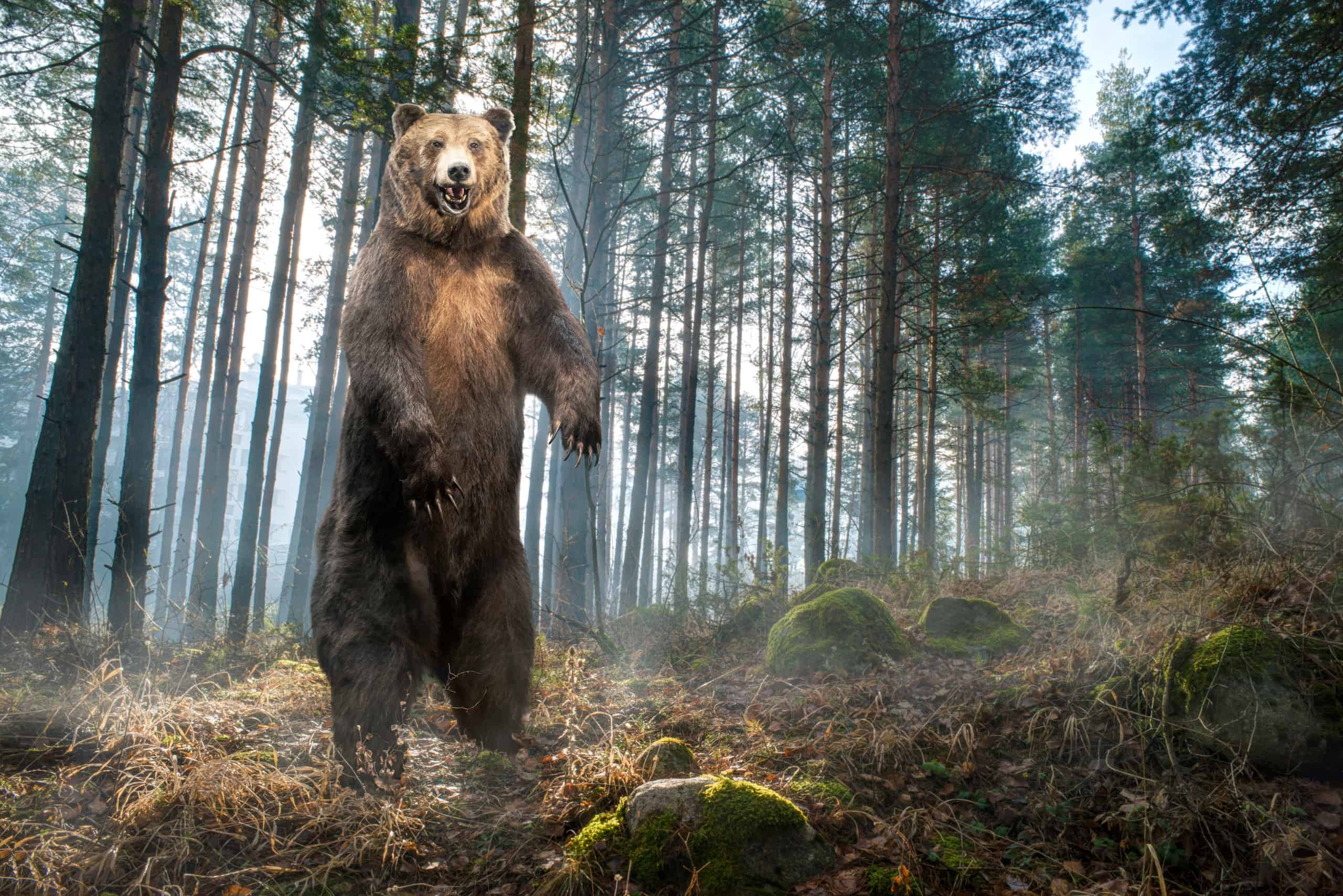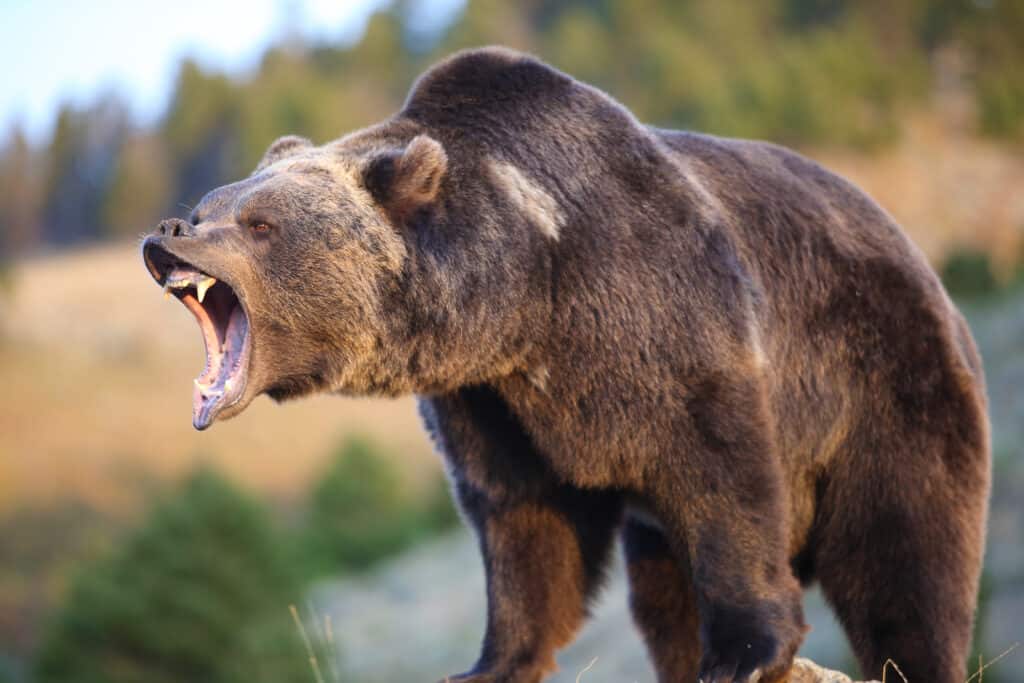
A grown grizzly bear shows off his great height by standing on two legs in the forest.
©Degimages/Shutterstock.com
Bears are some of the most fascinating animals in the world. One of their many attractive qualities is their size. However, if you think the bears that exist now are huge, you should see the ones that lived millions of years ago. Currently, the biggest bear species in the world is the polar bear, and bears that existed before now were at least two times bigger than the polar bear.
The largest bear to ever exist was the Arctotherium angustidens, the 4000-pound bear that trumps the polar bear that stands at an average of 1300 pounds. For the sake of this article, we shall refer to these massive bears as Arctotherium. These bears are an extinct genus of Pleistocene short-face bears that were endemic to Central and Southern America. The closest living relative to Arctotherium is the spectacled bear of South America.
Another species of modern-day bear that grows really big is the grizzly bear, a type of brown bear that was once plentiful in the western and northwestern United States. Northwestern Montana and the areas around Yellowstone National Park are home to most of the 1,500 grizzlies that still exist in the lower 48 states. There are also numerous grizzly bears in both interior Alaska and northern Canada. From the data available on both species, it is evident that the Arctotherium could easily beat the grizzly in a fight, but what about against three grizzlies? Do you think the Arctotherium could win against three grizzlies? Let’s find out.
Comparing an Arctotherium and a Grizzly Bear

The Arctotherium was five times bigger than most of the bears that exist today. This accurately describes the tremendous magnitude. These bears grew as large as 4,000 pounds and reached heights of 11 and 14 feet on their hind legs. The males of these bears were significantly larger than the females, with the bulk of their weight being more evident in their size than in their height. The scientific name of Arctotherium means “bear beast.” Its origins include the Greek words arktos, which means bear, and theria, which means wild animal or beast.
Because of their shorter snouts, Arctotherium angustidens are occasionally referred to as short-faced bears. Their shorter faces were much more distinct and visible in comparison to current bears due to their enormous bodies. During the Pleistocene era, which spanned between 2.6 million and 11,700 years ago, these bears were most prevalent in South America. By the end of this time, they had made their way to Central America and then to North America.
On the other hand, grizzlies are nowhere as big as Arctotherium. These bears reach only 900 pounds, and their females are even smaller, reaching only between 300 to 400 pounds, with a few reaching 500. Compared to the staggering height of an Arctotherium, grizzlies only reach a height of about eight feet standing on their hind legs.
In the past, grizzly bears could be found from Alaska to Mexico and from the Pacific Ocean to the Mississippi River. However, as the West expanded, grizzly bear populations drastically decreased. Alaska currently has the largest number of grizzlies. These bears can also be found in large numbers in some parts of Canada.

Grizzly bears live about 25 years in the wild.
©Lubos Chlubny/Shutterstock.com
How Long Do These Bears Live?
There’s no good way to be sure about the Arctotherium as far as lifespan goes. But we do know how long bears live today, of course. We summarize that it would be a similar amount of time. As with most animals, living in the wild increases lifespan versus living in captivity.
Most bears live, on average, to be around 25 years old, but it has been documented that they can live longer!
Key Factors To Consider in a Fight Between an Arctotherium and a Pack of Grizzlies
Although these animals are bears, there is still some difference in their build, strength, and offensive and defensive abilities. Determining which would win is subject to a lot of factors that we will carefully consider below.
Arctotherium vs. Grizzly Bear: Size
The most noticeable difference between these two bears is their size. The Arctotherium was at least four times bigger than the average grizzly bear. The smallest Arctotherium weighed around 2000 pounds, but they grew as large as 4000 pounds on average. Like all bears, these big boys walked on all fours, but when they stood on their hind legs, they reached an average height of about 11 to 14 feet, with some even averaging 16 feet.
Grizzlies are not as big; these bears reach an average of 900 pounds, and the females are even much smaller, averaging between 300 to 400 pounds. The average height of a grizzly bear is three to five feet at the shoulder when on all fours, and they can reach approximately nine feet when standing on their hind legs.
The Arctotherium has the size advantage over the grizzly bear.
Arctotherium vs. Grizzly Bear: Offensive Capabilities

Dangerous and strong, grizzly bears have long, sharp claws and a bite force of 975 PSI.
©Dennis W Donohue/Shutterstock.com
When it comes to offensive prowess, grizzly bears are absolute powerhouses. They have long, sharp claws that can rip adversaries apart, a forceful swipe, and a bite with a biting power of 975 PSI. They can dive after their prey or wait for them at the base of trees. These animals are extremely dangerous and strong.
On the other hand, the Arctotherium was big enough to take down many animals, including large prey. These bears were larger and stronger than even polar bears, which are currently the largest bears in the world. It’s unclear if the Arctotherium was a carnivore or an omnivore, but even if it ate some plant material, it was capable of hunting when it wanted to because of its size, sharp claws, and teeth.
The Arctotherium has an offensive advantage.
Arctotherium vs. Grizzly Bear: Speed and Mobility
Grizzly bears can run at speeds of 35 to 40 mph, making them the fastest members of the Ursidae family. Although they are unable to sustain this top speed for very long, their amazing ability to sprint quickly and maintain high speeds makes them incredibly effective predators.
On the other hand, the exact speeds of the Arctotheirum are undetermined. However, their closest living relatives, speckled bears, are able to run up to 30 mph, making them one of the fastest bears. Going by this, experts believe that the Arctotherium was a little quicker than the speckled bear.
Who Would Win in a Fight Between an Arctotherium and a Pack of Grizzlies?

It would be quite impossible for the Arctotherium to win against three grizzly bears.
©Joseph Scott Photography/Shutterstock.com
The Arctotherium would have won in a fight against one grizzly bear but not against three. The Arctotherium was much bigger, stronger, and scarier than the present-day grizzly bear. However, despite its size and strength, it would in no way win against three grizzlies simultaneously. No matter how strong this bear was or how many defenses it had, it would have been challenging to fight three other bears at the same time, with each one attacking simultaneously.
However, this bear would not have gone down without a fight. The Arctotherium was still bigger than three averagely-sized grizzlies combined, and because of this advantage, it would have been able to cause some damage to the grizzlies even before giving up the fight. Having the grizzlies attacking the Arctotherium at the same time and landing a couple of powerful swipes and bites would weaken it.
The photo featured at the top of this post is © Scott E Read/Shutterstock.com
Sources
- Dinopedia, Available here: https://dinopedia.fandom.com/wiki/Arctotherium
- Academia, Available here: https://www.academia.edu/5789813/The_Largest_Known_Bear_Arctotherium_angustidens_from_the_Early_Pleistocene_Pampean_Region_of_Argentina
- Wilderness Times, Available here: https://wildernesstimes.com/how-fast-can-a-bear-run/
Thank you for reading! Have some feedback for us? Contact the AZ Animals editorial team.






